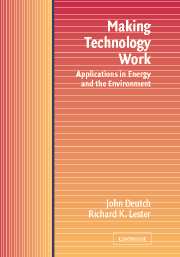Book contents
- Frontmatter
- Contents
- Preface
- 1 Introduction
- 2 Gasohol
- 3 Solar Thermal, Windpower, and Photovoltaic Technologies
- 4 Electricity from Coal
- 5 Controlling Acid Rain from Coal-fired Power Plants
- 6 Greenhouse Gases and Global Warming
- 7 Nuclear Power and Its Fuel Cycle
- 8 Managing Nuclear Waste
- 9 Nuclear Power and Weapons Proliferation
- 10 Natural Gas
- 11 Safety and Risk: Examples from the Liquefied Natural Gas and Nuclear Industries
- 12 Synthetic Fuels
- 13 Fuel Cells For Automobiles
- 14 Energy Models and Statistics
- 15 The Government's Role in Innovation
- 16 Conclusions
- Index
5 - Controlling Acid Rain from Coal-fired Power Plants
Published online by Cambridge University Press: 10 December 2009
- Frontmatter
- Contents
- Preface
- 1 Introduction
- 2 Gasohol
- 3 Solar Thermal, Windpower, and Photovoltaic Technologies
- 4 Electricity from Coal
- 5 Controlling Acid Rain from Coal-fired Power Plants
- 6 Greenhouse Gases and Global Warming
- 7 Nuclear Power and Its Fuel Cycle
- 8 Managing Nuclear Waste
- 9 Nuclear Power and Weapons Proliferation
- 10 Natural Gas
- 11 Safety and Risk: Examples from the Liquefied Natural Gas and Nuclear Industries
- 12 Synthetic Fuels
- 13 Fuel Cells For Automobiles
- 14 Energy Models and Statistics
- 15 The Government's Role in Innovation
- 16 Conclusions
- Index
Summary
The acid rain case considered in this chapter is an example of good government decision making. The history of federal acid rain control legislation demonstrates that it is possible for the government to arrive at an environmental control strategy that minimizes the costs of bringing about reductions, and that is at least consistent with analyses of the costs and benefits of alternative courses of action. The rational approach to decision making in this case is very different from the story of the federal gasohol program presented in chapter 2.
The public is greatly concerned about the environmental impact of emissions from coal-fired electric power plants. An important question is how much of society's resources should be spent on reducing the environmental impact of electricity generated from coal. As discussed in the preceding chapter, there are many different consequential emissions that must be considered, including carbon dioxide (CO2), sulfur dioxide (SO2), oxides of nitrogen (NOx), particulates, heat, and solid and liquid wastes.
In this chapter we consider the gaseous emissions of SO2 and NOx. These emissions form acids when combined with moisture in the atmosphere. The possible result is the phenomenon of “acid rain,” in which rain falling at a considerable distance from the originating plant (perhaps across a national border) has high acidity. This high acidity rain can harm forests, vegetation, lakes, and the fish the lakes contain; indeed, acid rain impacts the entire ecology.
- Type
- Chapter
- Information
- Making Technology WorkApplications in Energy and the Environment, pp. 66 - 80Publisher: Cambridge University PressPrint publication year: 2003



